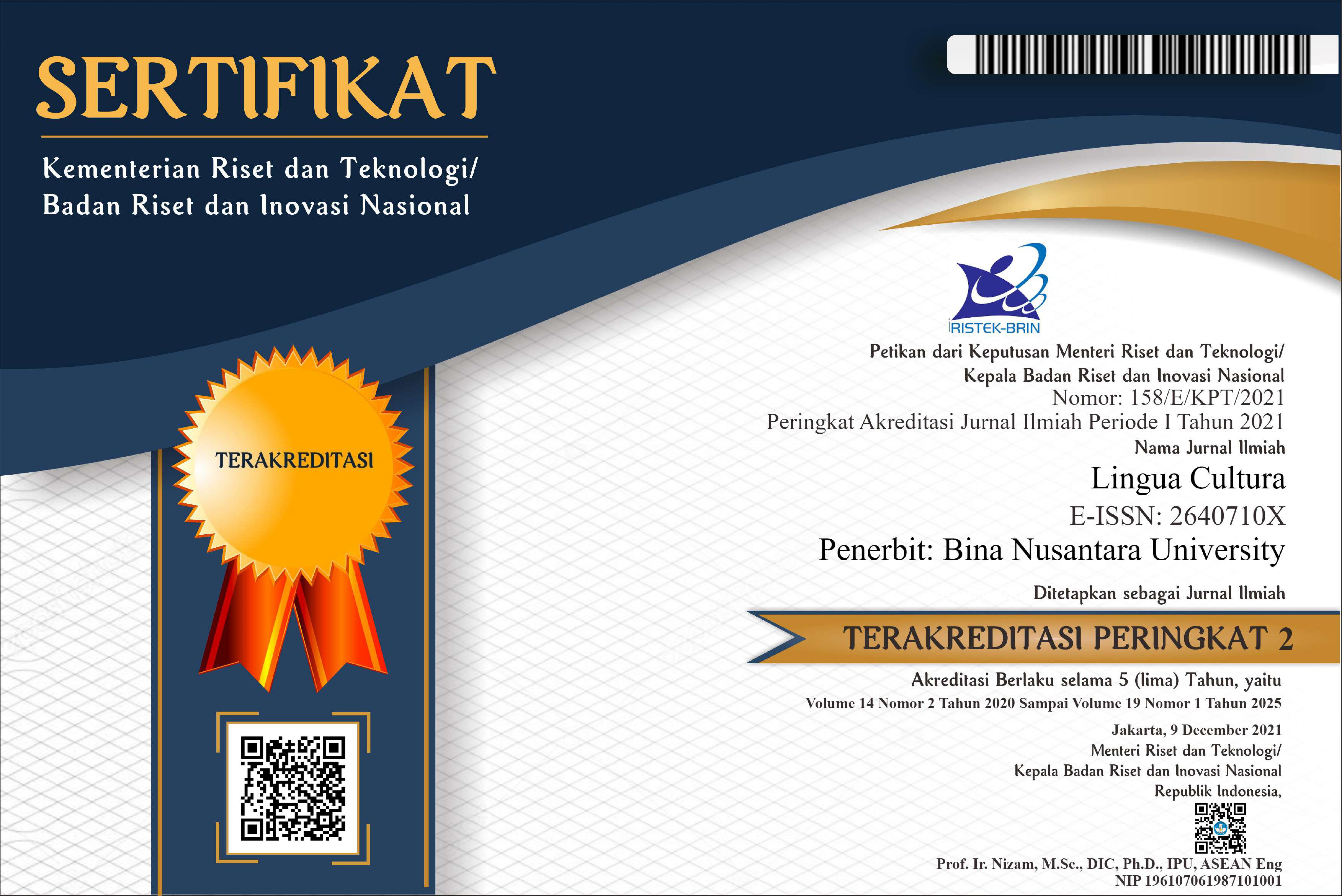Teacher’s Use of Code Switching in the Classroom and Its Implications on Students’ Score
DOI:
https://doi.org/10.21512/lc.v1i2.318Keywords:
code switching, foreign language, native language, classroom, studentAbstract
Code switching is usually done by people who have mastered two languages well. Among the people who can fulfill these criteria are Indonesians who teach English. In teaching English to Indonesian students, English teachers do not always use English as the medium of instruction, they usually code switch to Indonesian. Research focuses on the teachers as the subjects who apply code switching in the classroom. The respondents are eight lecturers in Bina Nusantara University who teach English to non-English department students. This research analyses the speech of the teachers to find out the percentage of code switching and the uses of code switching in the classroom. Finally, the relation between code switching and the students’ scores is calculated using independent samples T-test.
Plum Analytics
References
Auer, Peter. 1999. Code Switching in conversation Language, Interaction and Identity. London: Routledge.
Atkinson, David. 1987. “The Mother Tongue in the Classroom: A Neglected Resource?” ELT Journal Volume 41/4. Oxford: Oxford University Press.
Breitborde, LB. 1983. Level of Analysis in Sociolinguistic Explanation: Bilingual code Switching. Social Relation and Domain Theory. In Fishman (Ed.).
Fishman, Joshua A. (Ed). 1985. International Journal of the Sociology of Language. Paris: Mouton.
Holmes, Janet. 2001. An Introduction to Sociolinguistics. London: Longman.
Harbord, John. 1992. “The Use of the Mother Tongue in the Classroom.” ELT Journal Volume 46/4. Oxford: Oxford University Press.
Harmer, J. 1983. The Practice of English Language Teaching. London: Longman.
Haycraft, J. 1983. An Introduction to English Language Teaching. London: Longman.
Ianzity, Joanne Rolin and Siobhan Brownlie. 2002. Teacher’s Use of Learners’ Native Language in the Foreign Language Classroom. Canadian Modern Language Review, Vol. 58.
Irujo, Suzane. 2004. “One Classroom, Two Languages: Which Language When?” ELL Outlook, online journal.
McKay, SL and Hornberger (Ed.). 1996. Sociolinguistics and Language Teaching. Cambridge: CUP.
Myers-Scotton, Carol. 1993. Social Motivation for code Switching. Oxford: Clarendon.
Nivens, Richard. J. 2002. Borrowing Vs Code-Switching. Dallas: SIL.
Polio, C. and P. Duff. 1994. “Teacher’s Language Use in University Foreign Language Classroom: A Qualitative Analysis of English and Target Language Alteration,” The Modern Language Journal, Vol. 78.
Romero, Migdalia and Angela Parrino. 1994. “Planned Alternation Language (PAL): language Use and Distribution in Bilingual Classroom,” The Journal of Educational Issues of Language Minority Students, Vol.13.
Sert, Olcay. 1998. “The Function of Code Switching in ELT Classrooms”. I-TESL-J. Ankara: Haccetepe University.
Skiba, R. 1997. “Code Switching as a Countenance of Language Interference,” Internet –TESL-Journal 3:10.
Trudgill, P. 2000. Sociolinguistics. London: Penguin.
Wattson, Anna Flyman and Niclas Burenhult. 1999. “Code Switching in Second Language Teaching of French,” Working Papers 47:59-72.
Wardhaugh, Ronald. 1998. Sociolinguistics. Oxford: Blackwell.
Downloads
Published
Issue
Section
License
Authors who publish with this journal agree to the following terms:
a. Authors retain copyright and grant the journal right of first publication with the work simultaneously licensed under a Creative Commons Attribution License - Share Alike that allows others to share the work with an acknowledgment of the work's authorship and initial publication in this journal.
b. Authors are able to enter into separate, additional contractual arrangements for the non-exclusive distribution of the journal's published version of the work (e.g., post it to an institutional repository or publish it in a book), with an acknowledgment of its initial publication in this journal.
c. Authors are permitted and encouraged to post their work online (e.g., in institutional repositories or on their website) prior to and during the submission process, as it can lead to productive exchanges, as well as earlier and greater citation of published work.
USER RIGHTS
All articles published Open Access will be immediately and permanently free for everyone to read and download. We are continuously working with our author communities to select the best choice of license options, currently being defined for this journal as follows: Creative Commons Attribution-Share Alike (CC BY-SA)

















